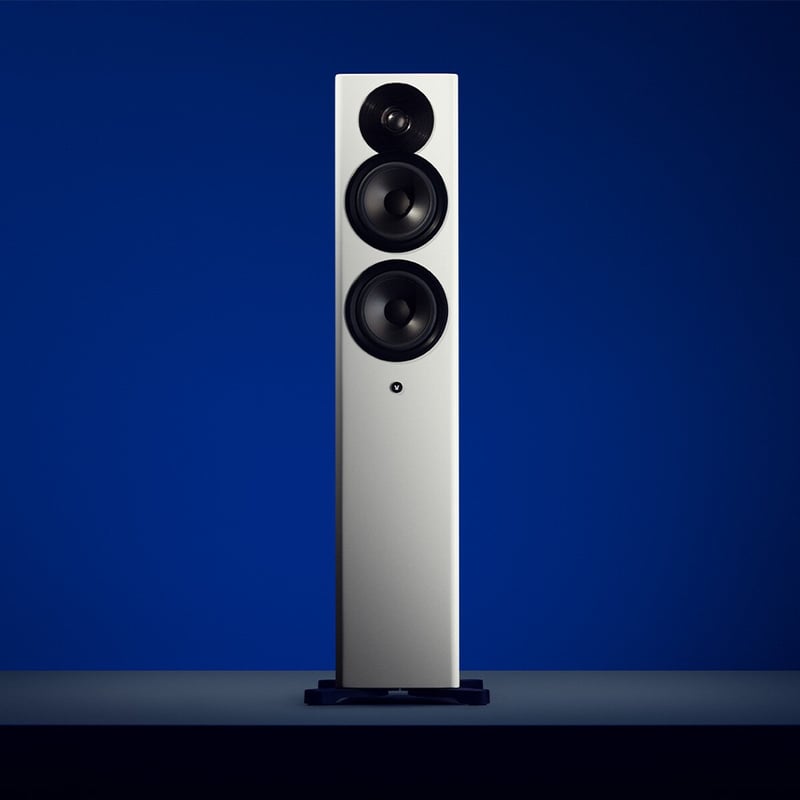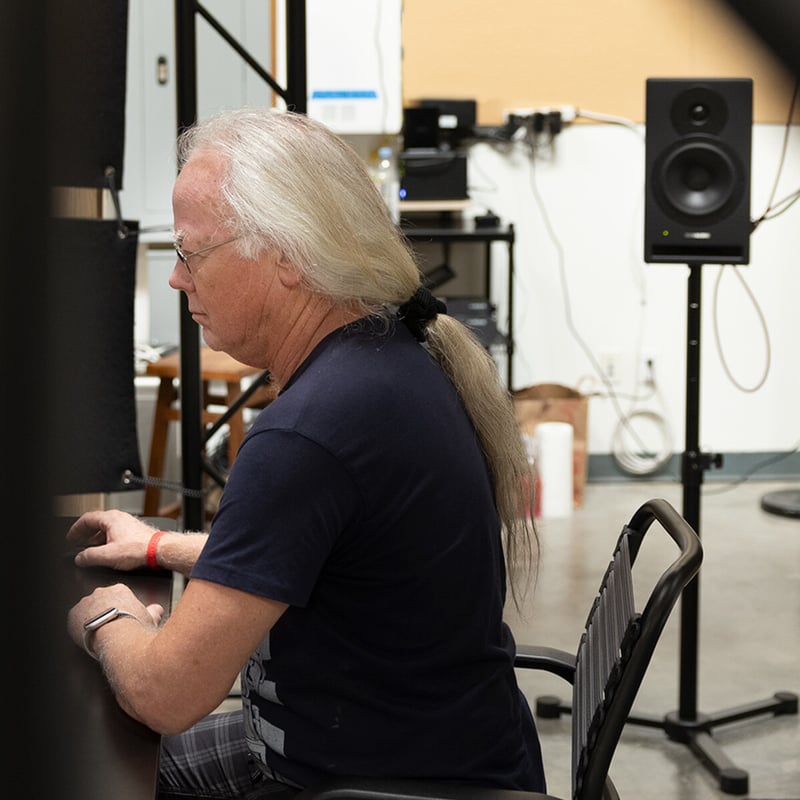We invited Roland Hoffmann, Senior Manager at the Dynaudio Academy, inside our Ask the Expert studio for a talk about active and digital crossovers.
This episode's questions
Watch the entire video above or skip directly to the question you find interesting by clicking the links below:
The first questions is from Jan. He wants to know what exactly makes something an 'active' crossover?
Picking up on Jan's question, Alexandros, Chris, and Jesper ask if we are changing to digital speakers with active crossovers all together? And what are the benefits with active ones compared to their passive counterparts?
Paul asks if we have considered integrating tone controls that boost high frequencies?
How do we tune our crossovers: for a flat EQ listening frequency spectrum or a more pleasant aural sound? Click here to see the answer to Craig's question.
The next question is from Fingerhut, who wants to know if it is possible to neutralize a 'suboptimal' speaker position through DSP and active crossovers?
Bill asks what has greater influence on the end-result: the impact of active crossovers or the lack of circuitry between the power output stage and voice-coils?
Is active and digital a short-term fix for driver quality? Here's your answer, Joshua.
We're at the episode's final question. And it's from Maxwell: will Dynaudio continue to make passive speakers or are you slowly making the entire line-up digital?.
Subscribe now: Ask The Expert on YouTube
Thank you!
We want to thank all of you who posted questions on our Facebook posts. We didn't have a chance to answer all of your questions, but we'll keep them in reserve - just in case.
Subscribe now: Ask The Expert on YouTube
If you have any more questions, please share them with us - and the rest of our community - on our Facebook page, in the comment section on YouTube or send us an E-Mail with your question.
All the best,
Roland and Christopher
Oh, you want more Ask the Expert?
Now that's something we can help you with!
In this episode, Jan Abildgaard Pedersen gets technical about Digital Signal Processing. Click here to see him pull out the whiteboard.
A loudspeaker is more than just 'one' part. Several things have to come together. Just as Roland said. In this episode, Andreas Eberhardt Sørensen talks about the same thing, but from a loudspeaker driver point of view.
Don't know how to clean your loudspeakers? No problem. Watch as Otto Jørgensen talks about some of the most common cleaning questions we get.
Transcript
Christopher Kjærulff, Content Manager: Hello and welcome to Dynaudio’s Ask the Expert. I am your host, Christopher, and today we are going to talk about active crossovers and to help us with that we have brought in Roland and Roland can you talk a little bit about yourself?
Roland Hoffmann, Senior Manager, Dynaudio Academy: Yes. I really think that Dynaudio makes the best loudspeakers on this planet but would you believe it, not everyone knows about it. So, my role in the Dynaudio Academy is to explain our loudspeakers, to introduce our technologies, to music enthusiast, to our dealers, to our distributors - basically worldwide.
Christopher: Yes, and I know you have just been to Australia.
Roland: Yes.
Christopher: And I am really envious of that trip. But without further ado let’s jump into the questions. Are you ready?
Roland: Let’s go.
Christopher: Perfect.
Christopher: Roland our first question is from Jan and he writes that he knows the Focus XD and the Xeo speakers, they are DSP based. He wants to know though what actually makes them active.
Roland: Yes. As you know every loudspeaker has to have a crossover. So, that is to split the frequencies so the tweeter receives the high frequencies, the mid-range, the mid and the woofer, the bass.
Christopher: Sure.
Roland: In a conventional system, this was all done in the analogue domain. So, the amplifier sends a full range signal to a crossover which is actually a filter network out of resistors, coils and capacitors. So, this receives the full range analogue signal and splits the frequencies.
Nowadays most music sources and music signal is in the digital domain. So, it makes a lot of sense to keep the digital music signal and also do this frequency split also in the digital domain. So, the Focus XD and the Xeo the crossover part actually looks like this. It is more a DSP. It is done fully in the digital domain. This is splitting the frequency and it is much more accurate because of that.
And now comes the active part of it. The active part is that after this frequency split in the digital domain every amplifier powers an individual drive unit. So, one amplifier for the tweeter, one for the woofer, one for the mids. And this makes the crossover both digital and also active.
Christopher: Perfect.
Christopher: As usual, Roland, when we ask for questions we get a lot of the same ones and this time it is Chris, it is Alexandros and it is Jesper who ask sort of similar questions. The essence of them was why are we changing to active speakers and active crossovers?
Roland: Yeah. We are not really changing to active loudspeakers. We have the new Contour range and from that you can see that we will always continue - the passive, the traditional loudspeakers.
And we make very good passive. So, we take a lot of care in choosing the right components and making good filter designs. So, we will continue with both. So, the Focus XD and the Xeo are actually adding to our range.
Christopher: And it is about adding new… Adding new choices for our customers.
Roland: Yes, not everyone wants the same type of loudspeaker.
Christopher: Precisely. The second part of their question -because there were two parts to it- is actually what is the benefit of using active crossovers, compared to passive.
Roland: Yes, it is a fair question. Because we make very good passive speakers. When you design a crossover filter, no matter how good you make it you always effect the analogue signal. There are always some side effects and also all of its components they influence each other.
So, it is much more accurate to do this frequency split in the digital domain. You keep the music signal -which remember it is digital anyway from most music sources- You keep in the digital domain and it is much more accurate. From then on comes the frequency split and the individual amplifiers. So yes, in a way no matter how good you do it, it is better to do it in the digital domain.
Christopher: Okay. So, just to get this right, when we do it digitally we keep the signal in the same domain for a longer time right?
Roland: That’s the key to it -and then we bring it to the next level which is why it is better- is if you split the frequencies and have individual power amplifiers for the tweeter, for the mid-range, woofer then you really bring up the performance level and these two elements make it actually better.
Christopher: So, in a three-way design like the Focus XD. You actually have three different amplifiers powering their own drive unit.
Roland: That’s right and we can specify the amplifier so it perfectly matches the drive unit and the drive unit -we make ourselves- so we know what is best for it.
Christopher: And that’s the benefit of it, right?
Roland: That is the benefit. And then you can make it actually better than a passive loudspeaker because a passive loudspeaker has an external amplifier and the amplifier and the loudspeaker - they do not know each other.
Christopher: No… And that of course in our active designs, we know the amplifier and we know the driver.
Roland: Exactly. Yes.
Christopher: Perfect.
Christopher: So, Roland we have a question from Paul and he is wondering if we ever thought about integrating tone controls for example to boost the high frequencies in our speakers. Especially as he writes “as it is nice to have flat response when you have a flat hearing reception.
Roland: Okay. Well Paul the good news for you and the bad news for anyone else is no one has a flat hearing - to start with. But yes, we added this in the Focus XD.
The Focus XD has a switch on the rear where you can tune the higher frequency response. So, you can set it to neutral you can set it to +1 so it slightly rises the high frequency - or you can set it to -1 so there is a slight decrease in the high frequency. So, you can tune it however you like the performance of the loudspeaker and you can also tune it according to your room acoustics.
So, if you have a room which is slightly bright you can also set it to -1 and have a better sound performance in your room.
Christopher: Okay, because, one of the things that I – when you say that you can set it +1 and -1 or neutral, one of the things I automatically start to think about is ok so what exactly – what would I hear if I put it on +1?
Roland: If I… The way we design it is that it not just increases the higher frequency but it is a tilt filter so it actually gives a slightly more open sound. Slightly more you can say brighter. But it is all done in the digital domain that’s the key thing here so whatever we have done to the tuning of the high frequency it is done in the DSP so it is done without any side effects. Remember the old analogue treble control on the amplifier that is doing more bad things than good things actually so we do it in the digital domain and it just gives the slight rise or slight decrease in the high frequencies in the digital domain.
Christopher: Cool.
Christopher: Our next question is from Craig and Roland he is wondering if – when we design our crossovers and when we tune them if we go for a flat EQ or if we actually tune them to have a more pleasant sound.
Roland: That is a good question. Because first of all everyone thinks about a flat frequency response and that is what to achieve. There is more than that in making a good loudspeaker. Maybe you have seen the photos of our new measurement room Jupiter. And we can really measure a lot of other things that has to be right like the phase response the impulse response the sound radiation of the loudspeaker.
So, first of all it is not only a flat response. There are many other things that have to be right however if something is not right and the measurements are ok but it doesn’t sound then the piano doesn’t sound like a piano we would rather go back in to our R&D phase and find the solution that measures good and sounds good so…
Christopher: So, Jupiter is actually a big benefit for us in that sense.
Roland: Definitely. But, it only works with using our ears… Ears of our engineers... So that is really important part of it. So, it’s both.
Christopher: But when we talk about that I start to think about that there is more to a loudspeaker than just a crossover obviously. We have the speaker cabinet; we have drive units; and there are obviously even things that I am not thinking about right now so is it just about the crossover or are we talking about all of these parts?
Roland: Yeah just like Craig explains or asks. Definitely, we are coming from the drive unit side we are not coming from the DSP side or the crossover side. We make the woofers and the tweeters right first then we make a very good cabinet design. The crossover -be it in the DSP- digital domain or the analogue domain comes very later stage. Because this is the music signal - the crossover that is the music signal and that should be – that should come at the last point if possible.
Christopher: But we focus on actually bringing all of these things together to build a good loudspeaker in the end.
Roland: Exactly and that is the key to better performance. If you do all the things right then you really get a much better loudspeaker.
Christopher: Perfect.
Christopher: So, we have a question from a Mr. Fingerhut. And I must say Roland, that is a cool name. But if we get back to his question, he wants to know when you have a speaker in a suboptimal position– as I guess a lot of people do – is that actually anything that we can do via DSP or crossover to neutralise the effects of that suboptimal position.
Roland: Yes, actually the room of Mr. Fingerhut is quite common. In the ideal world, you would place the speaker far away from the walls. Far away from the rear walls far away from the side walls to get the best sound performance.
In the real world, in a normal living room this is not really possible most people have to place their speaker closer to the rear wall. Everyone knows what happens then. You get an exaggerated bass. You get a lot of bass boom and in the Focus XD we have implemented room position speaker position equalizing. Which effects only the frequencies that lead to these problems. So rather than just killing off all the bass what we have done in the DSP is -by using the setting- the frequencies -I call them problem frequencies- are reduced which is generally around 80 Hz. So, 70-80-90 Hz. These are the problems… These are the frequencies that make all the problems whereas the low bass is not so much affected.
Christopher: Okay, and we can take that into consideration in the DSP.
Roland: In the DSP that is the good thing. You remember again the bass control on the old amplifier. That is probably handling all the wrong frequencies because that bass treble knob doesn’t even know what the problems are so we are just reducing the bass which is not the key to… this is not the solution.
The solution is to know about what actually happens when you move the speaker to the rear wall and our engineers measure what’s going on we have some clever guys who knows all the things about room acoustics and about how to do or implement that in the DSP.
Christopher: So, we measure to find those - you call them problem frequencies. Then we use clever people that can develop algorithms to reduce a boost or whatever it is needed.
Roland: Yes, that is exactly what we have done.
Christopher: Okay, perfect.
Roland: Yeah.
Christopher: The second part of Mr. Fingerhut's question is regarding the new firmware we did for the Focus XD. Can you talk a little bit about what we did with it?
Roland: Basically, it has the same function so we have the speaker position EQ again but the DSP has much more headroom and power.
Christopher: So, it can do better calculations…
ROLAND: Exactly! So, we implemented even better, or in more accurate equalisation of what happens and what is the solution to these problems. So, it is not only reducing the frequencies we also took into account some phase issues and some other frequencies. So, yeah, it works even better. It is even more accurate…
Christopher: Perfect.
Christopher: So, Bill you have sent us a question and it is about what has greater impact: is it the fact that we are using active crossovers or is it the fact that there is no circuitry between the power output and the voice coils.
Roland: What it is actually it’s both. In the conventional system, the amplifier is a relatively stupid machine. It just sends out the music signal to the loudspeaker. And there is no real interaction. The amplifier designer did not know about the crossover, about the loudspeaker. And we do not know which amplifier is gonna be used with our loud speakers. So it is not really a good match - having a more direct link between the amplifier and the drive unit as we do in the Focus XD in the Xeo is just a great benefit.
Christopher: So, Bill, it is a bit of both.
Christopher: Ok the next question Roland is from Joshua and he wants to know if active speakers or active crossovers are they actually just short term solutions to speakers with bad drivers?
Roland: Yeah, that’s a fair question because there a few loudspeakers out there, actually a lot of loudspeakers are out there which work that way... It is very tempting to buy a cheap drive unit and then - even now it has some shortcomings in the electronic way - So, in the crossover or in the amplifier design- which leads to very average sound quality.
So, if you have some resonance in the drive unit this should be taken care of in the drive unit and not suppressed in the electronic way in the music signal. So, the way we work is that we first of all get the drive unit right- the woofers and the tweeter performance- then we added DSP based crossover and the amplification. That is one of the rare cases where one plus one is more than two. You really get up the performance of both together.
Christopher: Ok so as we talked about earlier. It is really about combining a lot of good stuff and then ending up with something that…
Roland: Yes and that is actually makes the Focus XD and Xeo so good.
Christopher: Perfect.
Christopher: So Roland we are at the end of the day. It is the last question and it is from Maxwell and he wants to know whether or not we are changing to only do digital speakers or are we still going to make passive ones?
Roland: Yes, I think the new Contour answers that one quite nicely. We will have excellent passive speakers as well. Focus XD and Xeo are quite successful for Dynaudio because people like the performance and they still have less products in the living room. Less hi-fi components. So, from that we take it that this is really the way to the future.
On the other side, there are many people who would like to buy passive speaker and buy a certain amplifier. They love the sound of a Class-A amp or a tube amp or certain speaker cables. And that is part of the hobby. And we will always make loudspeakers for these Hi-Fi systems. So, the future lies in both.
Christopher: I think that is perfect.
Christopher: Unfortunately, we are out of time. But we truly appreciate all of your wonderful questions and for you to take the time out of your day and send them to us.
Roland thank you so much for joining us today.
Roland: Welcome - it is really good.
Christopher: Yeah. And see you next time…
Sign up to get more great articles
Nothing compares to the satisfaction of knowing – for a fact – that something is as good as it gets





